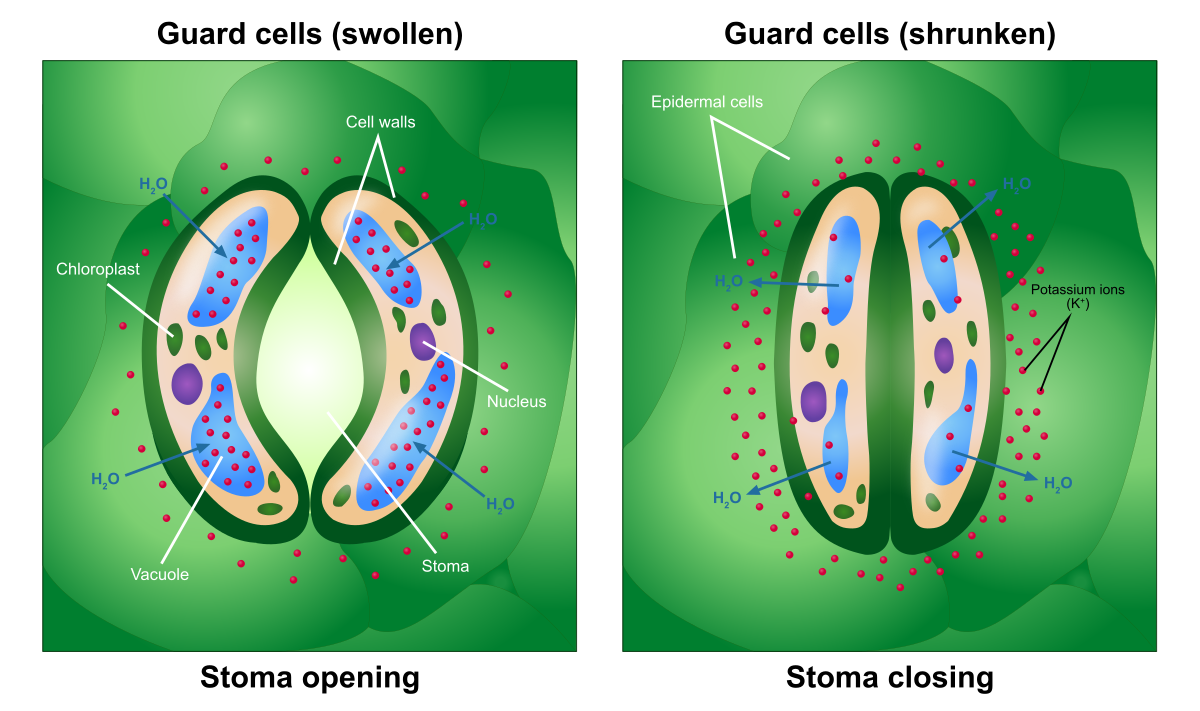
The opening and closing of stomata are controlled by the activity of
a. Guard cells
b. Epidermal cells
c. Mesophyll cells
d. Lenticels
Answer
476.4k+ views
Hint: Tiny apertures on the epidermis of leaves that facilitate the exchange of gases like carbon dioxide and oxygen are known as stomata. These apertures remain guarded so that rate of water loss and gaseous exchange can be controlled. These structures are present on the aerial parts of the plants, in particular on the leaves. They can also be uncommonly present on stems and flowers.
Complete answer:
The stomata are present on the epidermis of leaves. Each stoma is protected by two guard cells on either side. The guard cells are bean shaped cells with very permeable cuticles and abundant chloroplasts. They open and close in response to the presence of starch and sugar in them.
During the day when light is available, the plants undergo the process of photosynthesis. The guard cells, because of their chloroplasts are no exception. Therefore, the amount of sugar and starch in these cells increase. As a consequence, the concentration in the guard cells is more than that of its surroundings which causes water to rush into these cells by osmosis. As a result, the guard cells become turgid or they ‘open’.
During the night, in absence of photosynthesis reduces the sugar content of the guard cell. The water rushes out of the cells due to lower concentration inside. This causes the cells to become flaccid or they ‘close’.

Epidermal cells are various types of cells on the epidermis of plants. They are analogous to the skin epidermis and cover the entire plant surface. Their main function is to protect the plant body from different microbes, chemical compounds and even ultraviolet rays.
Mesophyll cells are found between the upper and lower epidermis. The tissue is composed of two types of cells – the Palisade cells and the Spongy cells. The mesophyll cells take part in photosynthesis.
Lenticels are tiny pores present on the surface of fruits and stems. They are composed of parenchymatous cells and always remain open. These pores facilitate gaseous exchange between the atmosphere and the plant.
Hence, the correct answer is option (A).
Note: Stomatal openings are guarded by guard cells. The change in structure of these cells facilitate opening and closing of the stomata, which in turn takes place in response to the presence of light. Stomatal opening and closure may also result from the presence or absence of water in the surroundings. During drought or water shortage, the stomatal pores are known to close, thereby reducing the rate of water loss.
Complete answer:
The stomata are present on the epidermis of leaves. Each stoma is protected by two guard cells on either side. The guard cells are bean shaped cells with very permeable cuticles and abundant chloroplasts. They open and close in response to the presence of starch and sugar in them.
During the day when light is available, the plants undergo the process of photosynthesis. The guard cells, because of their chloroplasts are no exception. Therefore, the amount of sugar and starch in these cells increase. As a consequence, the concentration in the guard cells is more than that of its surroundings which causes water to rush into these cells by osmosis. As a result, the guard cells become turgid or they ‘open’.
During the night, in absence of photosynthesis reduces the sugar content of the guard cell. The water rushes out of the cells due to lower concentration inside. This causes the cells to become flaccid or they ‘close’.

Epidermal cells are various types of cells on the epidermis of plants. They are analogous to the skin epidermis and cover the entire plant surface. Their main function is to protect the plant body from different microbes, chemical compounds and even ultraviolet rays.
Mesophyll cells are found between the upper and lower epidermis. The tissue is composed of two types of cells – the Palisade cells and the Spongy cells. The mesophyll cells take part in photosynthesis.
Lenticels are tiny pores present on the surface of fruits and stems. They are composed of parenchymatous cells and always remain open. These pores facilitate gaseous exchange between the atmosphere and the plant.
Hence, the correct answer is option (A).
Note: Stomatal openings are guarded by guard cells. The change in structure of these cells facilitate opening and closing of the stomata, which in turn takes place in response to the presence of light. Stomatal opening and closure may also result from the presence or absence of water in the surroundings. During drought or water shortage, the stomatal pores are known to close, thereby reducing the rate of water loss.
Recently Updated Pages
Master Class 12 English: Engaging Questions & Answers for Success

Master Class 12 Business Studies: Engaging Questions & Answers for Success

Master Class 12 Social Science: Engaging Questions & Answers for Success

Master Class 12 Chemistry: Engaging Questions & Answers for Success

Class 12 Question and Answer - Your Ultimate Solutions Guide

Master Class 12 Economics: Engaging Questions & Answers for Success

Trending doubts
Which are the Top 10 Largest Countries of the World?

Differentiate between homogeneous and heterogeneous class 12 chemistry CBSE

What is a transformer Explain the principle construction class 12 physics CBSE

Draw a labelled sketch of the human eye class 12 physics CBSE

What are the major means of transport Explain each class 12 social science CBSE

What is the Full Form of PVC, PET, HDPE, LDPE, PP and PS ?




